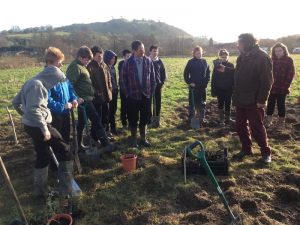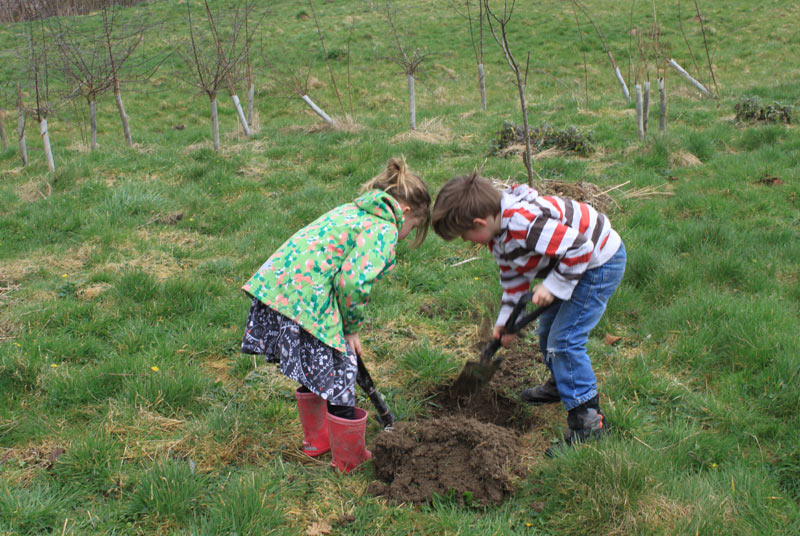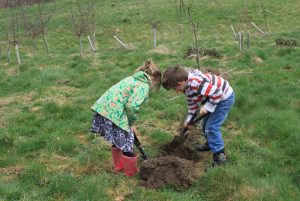
Forgive my poor Welsh but the image of children planting fruit trees in the Welsh spring (Children = plant, wood = coed) is too perfect a pun opportunity to miss out on!
There is wonderful soil down on the flood plain at Cae Bodfoch by the river Cain. Millennia of alluvial deposits have built a wonderful fertile soil there, it’s a little heavy with clay but with a high carbon content so it is open and aerated, perfect for growing. The presence of moles, who feast on worms whilst tunneling through the rich soil open up drainage and air-ways confirm its excellent fertility and potential.
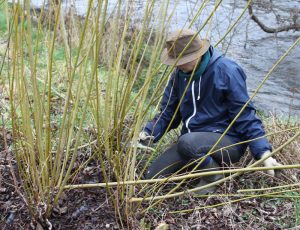
Fertile soils, moisture and full sun make an excellent space for growing. Over the last 3 or 4 years via local permaculture initiatives we have been able to introduce several willow coppice beds as well as establishing a heritage orchard there.
Willow plays many more important roles than just providing biomass for burning or materials for basketry.
The river is a spawning ground for trout who are very sensitive to silts and mud on the gravel beds where they choose to lay their eggs. Planting trees along riversides reduces the soils washing from surrounding farmland into rivers by filtering and cleaning any surface flow. Riverside plantings also stabilise soils on the banks with their roots, whilst the trees also provide habitat and food for insects and birds.
Project volunteers planted 80m of willow along the edge of the field for coppice two years ago using salix viminalis, a fast growing shrub willow long used for basketry, biomass and water filtration. We also designed the planting to provide a wildlife corridor from the river across the field in a way that also offers wind shelter to the wetland/ picnic area adjacent to it.
 This is a small part of the 10 acre area that has been given over to community use by the landowners at Bodfach hall, a little further up stream. There are a range of plans for how to use the rest of the field but protecting and enhancing wildlife and biodiversity was always a key consideration in this sensitive area.
This is a small part of the 10 acre area that has been given over to community use by the landowners at Bodfach hall, a little further up stream. There are a range of plans for how to use the rest of the field but protecting and enhancing wildlife and biodiversity was always a key consideration in this sensitive area.
 The process began a few years ago when the land first became available, people across the community were invited to submit ideas as to how it could be used for long-term community benefit. A variety of ideas were submitted, some fanciful but not practical, some practical but beyond budget and in many ways suggestions fell between the two but failed to have an overall coherence.
The process began a few years ago when the land first became available, people across the community were invited to submit ideas as to how it could be used for long-term community benefit. A variety of ideas were submitted, some fanciful but not practical, some practical but beyond budget and in many ways suggestions fell between the two but failed to have an overall coherence.
I took the proposition and gave it to a group of permaculture design graduate students in 2013 and again in 2014 and from that we evolved a plan that took into account the key potentials from a wildlife and biodiversity perspectives whilst aiming to create relationships and connections with the surrounding community at the same time. This is the nub of permaculture design, designing for personal goals and needs in a way that compliments, benefits and includes community objectives whilst working to maximise the benefit to and understanding of our place in the wider natural world.
Development vs enviroment
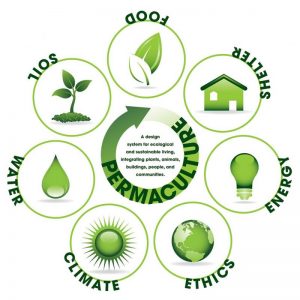 We could be forgiven for thinking that achieving development objectives entails sacrifice of the environment, because industry and developers always present habitat disruption as a necessary cost of progress. Permaculture design however refutes that view asserting that until we can reconcile the two objectives we will never achieve any degree of sustainable development. Furthermore Permaculture asserts that every development is a opportunity to enhance the environment and wider ecology, ceasing this continual erosian of natural capital.
We could be forgiven for thinking that achieving development objectives entails sacrifice of the environment, because industry and developers always present habitat disruption as a necessary cost of progress. Permaculture design however refutes that view asserting that until we can reconcile the two objectives we will never achieve any degree of sustainable development. Furthermore Permaculture asserts that every development is a opportunity to enhance the environment and wider ecology, ceasing this continual erosian of natural capital.
Whenever we are creating something we should be finding ways and approaches which benefit community and ecology, whilst of course achieving the original objective.
A plan for Cae Bodfach
With all of this in mind a plan evolved; the two groups of Sector39 students sifted through the minutes, plans and notes from the community and town council meeting and chatted with various stakeholders of the project before producing a design for the field. The student’s design had many elements in the final plan, so when it came to submitting it to the council we removed more speculative elements and concentrated on the backbone of the design, locating the key elements that fitted the brief given us by Llanfyllin town council, representing the community.

The orchard/ food forest is placed centrally to the field on the highest and richest ground on the flood plain. It avoids the power lines that cross the field and is arranged as a single island that the tractor which crops the hay each summer can easily navigate around.
We have added to the orchard each year since we began, firstly with support of the Cwm Harry Get-Growing project and latterly with help from the Welsh Cider and Perry society as well as this project. Year on year it is developing towards something we hope will be of real lasting value to the community and the wildlife of the area. We have planted some 50 heritage fruit trees now, with hundreds of support plants. Herbs, shrubs, bee-friendly flowers, berries and more have all been added to support the overall effect.
The vision fo the Cae Bodfach food forest is a community able to harvest useful quantities of fruit for its own use with surpluses available for juicing, jamming and fermenting – all of which could potentially be resold to generate income for community projects in the future.
Of course these plantings only take up a small part of the space available and are either at the extreme edges or in the middle of the field furthest away from the picnic areas and entrances. So those plans as yet unrealised and calling for more physical investment, skate parks and natural amphitheatres still have plenty of available space to evolve into but hopefully at least we have created something that makes the area more interesting and inviting to both the community and the ecology of the area.
